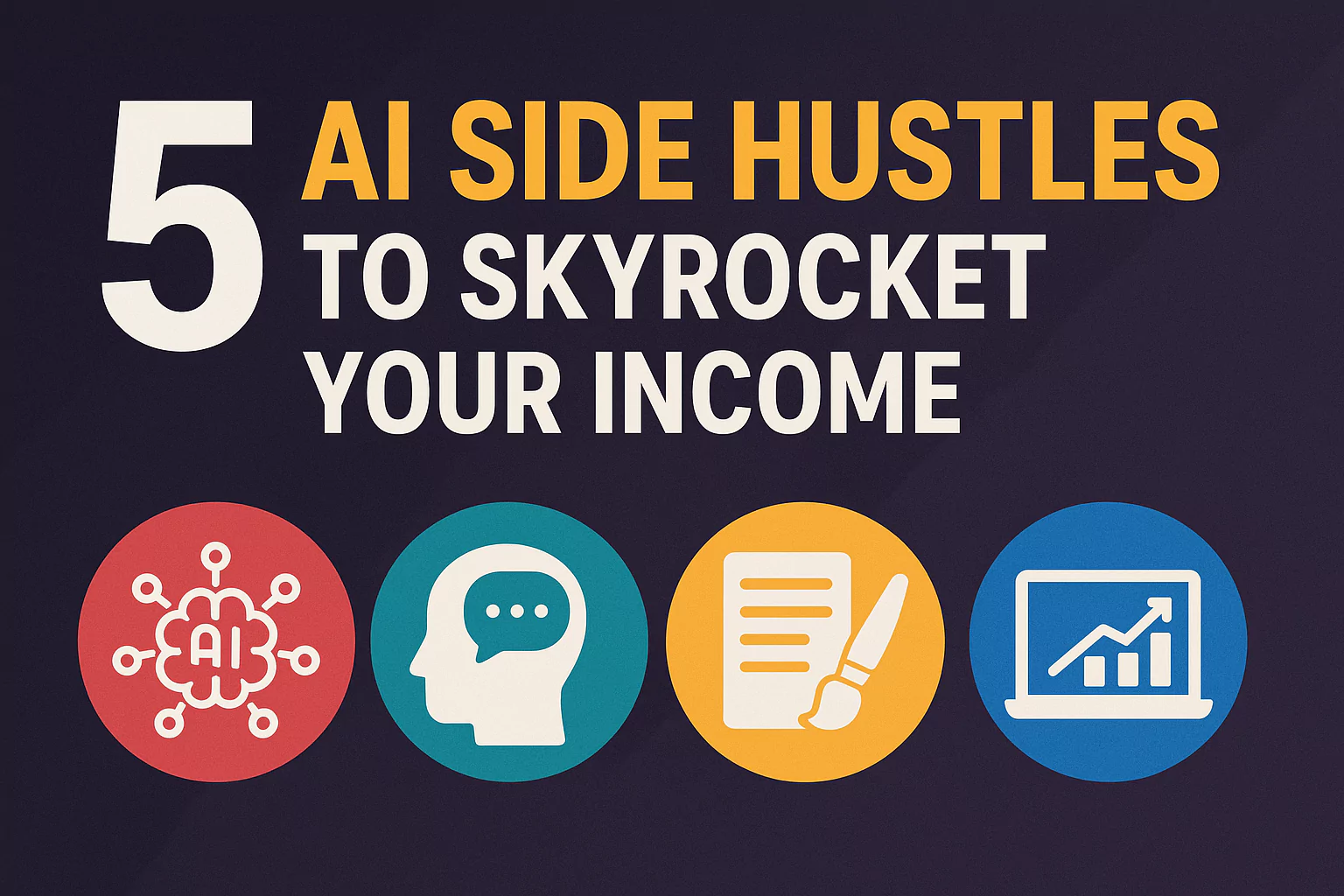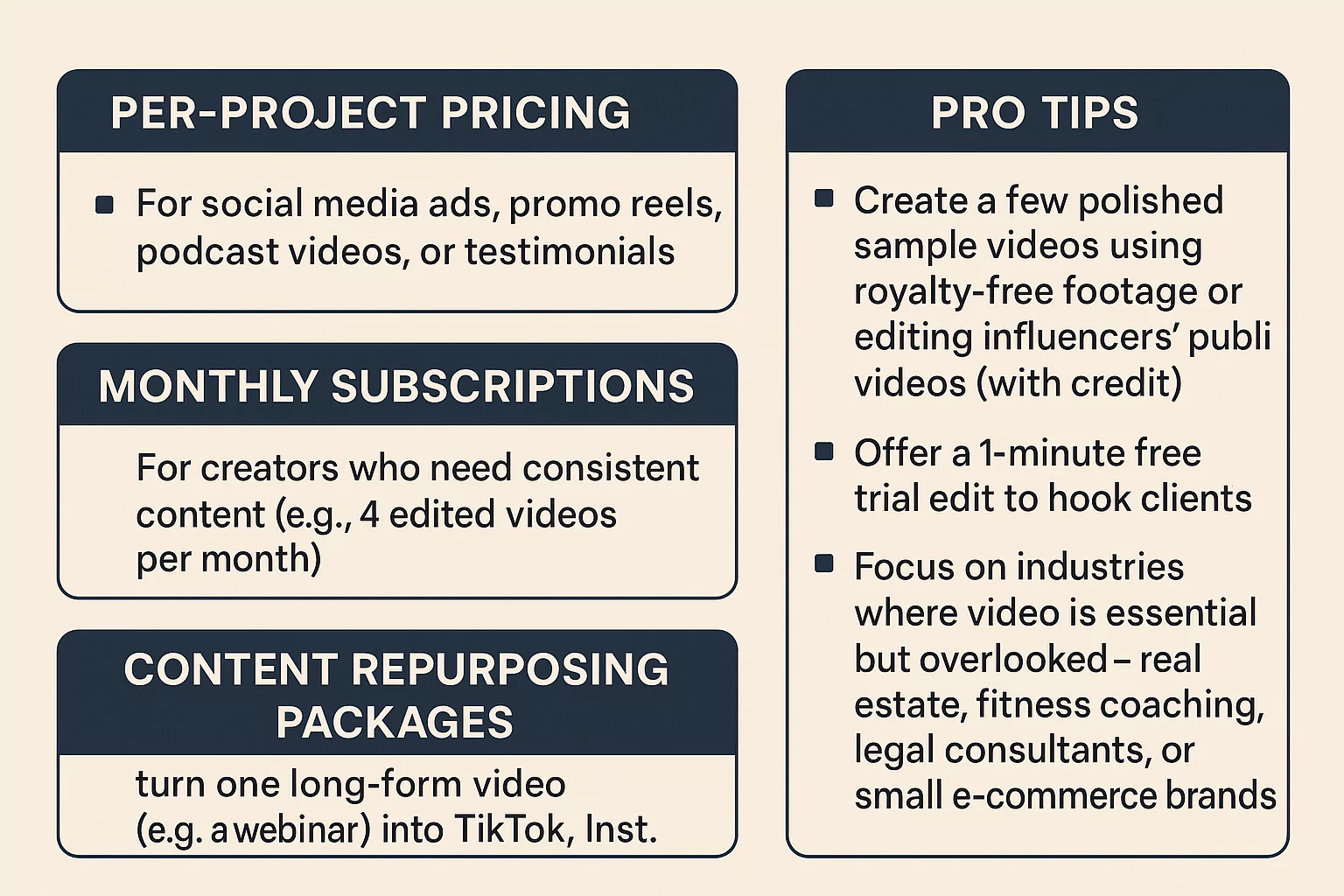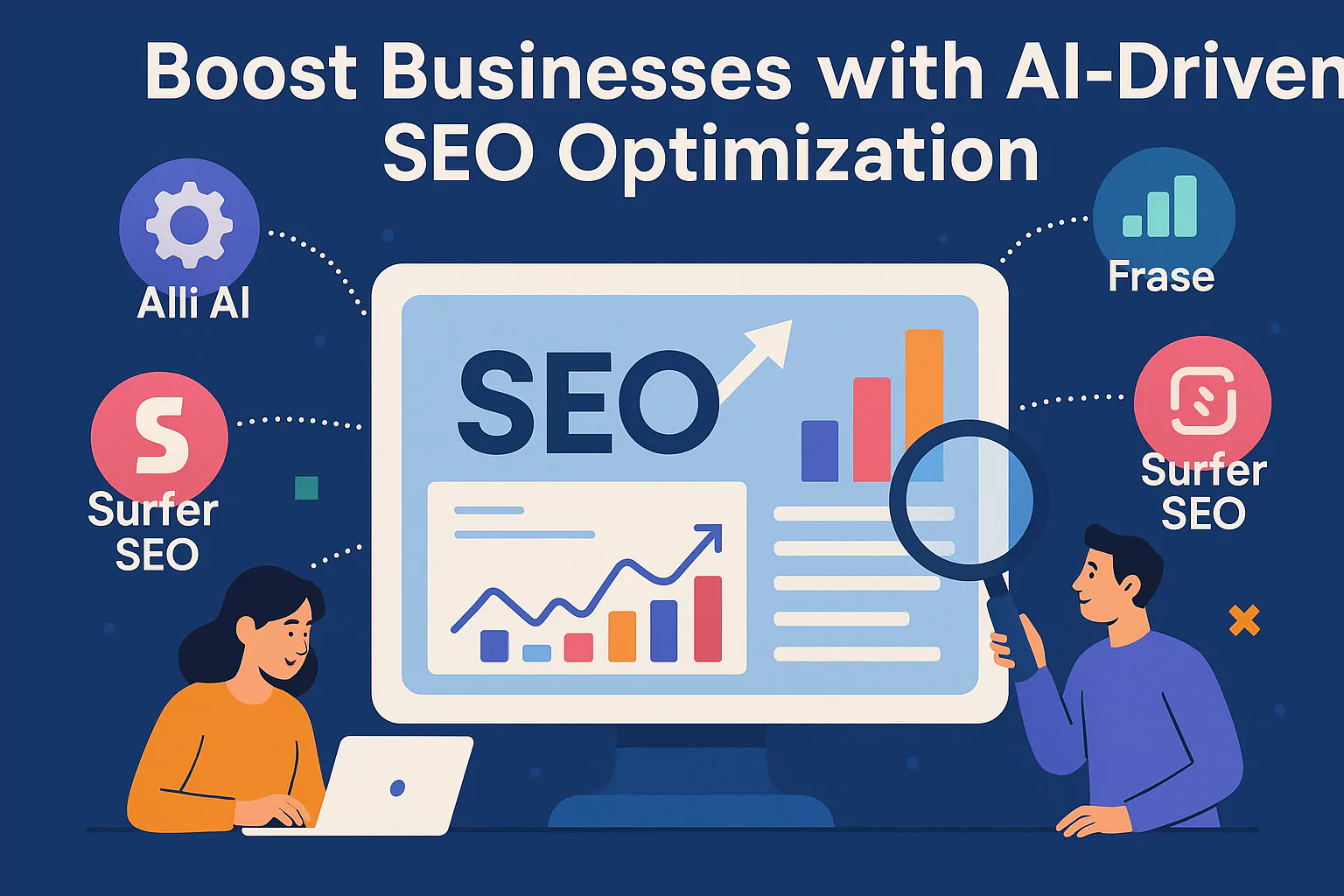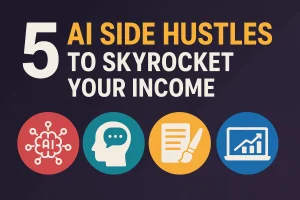Skyrocket Your Income : 5 AI Side Hustles
5 AI Side Hustles to Skyrocket Your Income
Artificial intelligence isn’t just reshaping corporate workflows—it’s opening new doors for everyday entrepreneurs. As AI becomes more accessible, it’s enabling individuals with little to no technical background to build profitable side hustles from home. According to a 2025 McKinsey report, 71% of organizations had adopted generative AI tools by March, up from 65% in early 2024—a clear sign that this tech is moving from novelty to necessity.
But this transformation isn’t limited to boardrooms and big budgets. Visionaries, independent professionals, and driven self-starters are harnessing AI to create income faster and at a scale never before possible. From automating tedious tasks to building custom tools for niche audiences, AI puts powerful capabilities into your hands—often with minimal upfront investment.
Whether you’re looking to earn a few hundred extra dollars a month or lay the groundwork for something bigger, this guide breaks down five practical, AI-powered side hustles that anyone can start today. Plus, we’ll wrap up with a quick-launch blueprint to help you turn ideas into action.

1. Build and Sell Custom GPTs for Niche Markets
With tools like ChatGPT becoming increasingly user-friendly, it’s now possible for individuals—not just developers—to create specialized AI assistants for almost any industry. These custom GPTs (Generative Pre-trained Transformers) are essentially tailored chatbots designed to solve very specific problems, from drafting legal documents to coaching sales reps or providing on-demand HR advice. The real value lies in hyper-niche automation: by targeting a narrowly defined user group, your GPT can become an indispensable productivity tool.

For example, imagine creating a GPT for real estate agents that helps write compelling property listings based on rough input notes, or a legal GPT that formats contracts using jurisdiction-specific templates. You’re not just building a chatbot—you’re offering a mini virtual assistant designed for a very particular pain point.
Now, the creative process is more accessible than ever before. Platforms like OpenAI’s GPT builder let you define the tone, capabilities, and training data for your GPT without deep coding knowledge. Once built, you can:
- Host it on a private or embedded site using no-code web builders.
- Offer freemium access, where users can try basic features before subscribing for full functionality.
- Market your GPT by identifying online communities (e.g., niche Facebook groups, Reddit threads, LinkedIn industries) and addressing real user frustrations.

Do your research: scan forums, review FAQs, and browse comment sections to uncover repetitive tasks professionals are desperate to offload. A well-positioned GPT that automates a boring, time-consuming process can generate passive income from dozens or even hundreds of users.
What makes this side hustle scalable is its digital nature—once the GPT is built and deployed, it can serve countless clients simultaneously, with minimal ongoing effort. And with businesses increasingly open to automation, your niche GPT could become their go-to solution.
2. Develop AI Microtools with Drag-and-Drop Platforms
Not ready to build a full chatbot? You don’t need to be. AI microtools—lightweight utilities designed to perform specific tasks—offer a simpler, faster way to break into the AI side hustle space. Thanks to no-code platforms like Gumloop, Pineapple Builder, and Glide, you can design powerful tools using intuitive drag-and-drop interfaces—no programming skills required.
These microtools can do anything from analyzing website SEO and summarizing research articles to generating job descriptions or streamlining client onboarding. For example, you might create a tool that evaluates LinkedIn profiles and offers tailored resume suggestions, or one that helps e-commerce sellers rewrite product descriptions for better search performance.
What makes microtools so appealing is their “build once, sell repeatedly” model. Once you’ve built a tool that works, you can license or sell it over and over again to a clearly defined audience. Better yet, you can stack several related tools into a toolkit bundle and offer them at a higher price point.

How to Market Your AI Microtool (or Custom GPT):
- Find Your Niche Audience: Look for professionals or small business owners who struggle with repetitive tasks. LinkedIn groups, Reddit threads, or even niche Slack communities are goldmines for insight. Pay close attention to the problems people complain about repeatedly.
- Validate Demand Before Building: Post a simple poll or mock-up of your tool in a relevant community and ask, “Would this save you time?” If you get traction, move forward.
- Build a Simple Landing Page: Use platforms like Carrd or Notion to create a clean, one-page site explaining what your tool does, who it’s for, and how it saves time or money. Embed screenshots, testimonials, or a 1-minute demo video.
- Offer a Freemium Model or Free Trial: Let users experience the benefit before they commit. Once they see time savings or improved results, converting them into paying users becomes much easier.
- Leverage Product Hunt or Indie Hackers: If your tool is polished and solves a clear problem, these platforms can drive traffic and help you build early traction.
Whether you’re solving a micro-task for real estate agents, teachers, recruiters, or online sellers, AI microtools provide a fast path to recurring income—without the complexity of full app development.
3. Streamline Video Editing with AI Tools
Video content dominates online engagement, but editing it remains one of the most time-consuming parts of content creation. Fortunately, AI-powered editing tools like Veed.IO, Runway, Descript, and Pictory can dramatically cut the time and skill required to produce polished videos. These platforms can automatically trim awkward silences, add captions, improve lighting, remove background noise, and even repurpose long videos into short, shareable clips.
As a side hustler, this opens the door to offering on-demand video editing services—even if you have little experience. Content creators, YouTubers, coaches, and small business owners constantly need video content but often lack the bandwidth or tools to polish their footage. That’s where you come in.

You can position yourself as a “rapid editor” who delivers fast, consistent, and high-quality edits using AI—at a more affordable rate than traditional editors.
Smart ways to monetize:
- Per-project pricing for tasks like social media ads, promo reels, podcast videos, or testimonials.
- Monthly subscriptions for creators who need consistent content (e.g., 4 edited videos per month).
- Content repurposing packages where you turn one long-form video (e.g., a webinar) into multiple short clips for platforms like TikTok, Instagram Reels, and YouTube Shorts.
Pro Tips:
- Create a few polished sample videos using royalty-free footage or editing influencers’ public videos (with credit).
- Offer a 1-minute free trial edit to hook clients.
- Focus on industries where video is essential but overlooked—real estate, fitness coaching, legal consultants, or small e-commerce brands.

By combining creativity with AI efficiency, you’re not just editing—you’re solving a time and resource problem in a fast-growing market.
4. Build Stunning Websites Effortlessly with AI-Powered Web Design
Building stunning, high-performance websites no longer requires web development expertise. Thanks to AI-powered platforms like Wix ADI, Jimdo, Zyro, and Bookmark, creating a sleek, responsive website takes hours—not weeks. These tools handle much of the heavy lifting by automatically generating layouts, selecting color palettes, optimizing mobile responsiveness, and even drafting basic text based on your prompts.
As a side hustler, this means you can quickly build websites for individuals and small businesses that desperately need an online presence but lack the time, skills, or budget to hire a full-service agency.

Who Needs This?
- Local service providers (plumbers, hair stylists, tutors, fitness coaches)
- Solo entrepreneurs and consultants
- Etsy or Shopify sellers who want a branded site
- Content creators and bloggers seeking to build authority
What You Can Offer:
- One-page business sites (e.g., portfolios, service menus, landing pages)
- Full website packages with blog integration, booking forms, and contact pages
- Proactive maintenance routine (monthly updates, automated backups, and periodic SEO adjustments)
Monetization Models:
- Flat rate per project (e.g., $300–$800/site depending on complexity)
- Tiered packages (Basic site vs. Advanced with email capture, SEO, etc.)
- Retainers for updates, performance checks, or seasonal redesigns
How to Stand Out:
- Use AI tools to generate a quick draft, then spend time on customization—adjusting colors, fonts, and copy to reflect the client’s brand voice.
- Offer a visual preview (Wix and Jimdo both allow preview links before publishing) so potential clients can see the value before committing.
- Build a personal portfolio showcasing 2–3 demo sites in different styles or industries to inspire trust and provide social proof.
AI takes care of the technical grind, so you can focus on big-picture creativity and fostering client connections. If you can combine speed, affordability, and clear branding, you’ll be a top choice for clients who just want a clean, fast website—without the traditional agency price tag.
Sample Sales Pitch Email – AI Web Design
Subject: Boost Your Online Presence with a Stunning Website—Built with AI
Hi [Client Name],
I noticed your business doesn’t currently have a strong online presence, and I’d love to help you fix that—quickly and affordably.
Using advanced AI web design tools, I can create a beautiful, mobile-friendly website tailored to your brand in just a few days. Whether you need a simple landing page or a full business site with booking features and contact forms, I’ll make sure your site looks professional and works seamlessly.
Here’s what you’ll get:
- A customized, responsive website
- Fast turnaround (2–4 days)
- Optional add-ons like blog setup, email capture, or SEO optimization
I’ve attached a few examples of past work, and I’d be happy to create a free homepage mockup so you can see what’s possible.
Happy to jump on a call if that would be helpful—just say the word
Best regards,
[Your Name]
[Your Portfolio Link]
[Contact Info]
3-Tier Pricing Model – AI Website Packages
Tier | What’s Included | Price |
Starter | 1-page website, mobile optimized, basic contact form, delivery in 3 days | $299 |
Professional | Up to 5 pages, custom branding, SEO basics, booking/calendar integration, blog setup | $599 |
Premium | Everything in Pro + monthly updates for 3 months, performance monitoring, 2 revision rounds | $899 |
Add-ons:
- Extra page: $50 each
- Email list integration: $75
- Ongoing maintenance: $50/month
5. Boost Businesses with AI-Driven SEO Optimization
Search engine optimization (SEO) remains one of the most valuable services a business can invest in—but it’s also one of the most time-consuming and confusing. That’s why AI-powered SEO tools like Alli AI, Frase, Surfer SEO, and MarketMuse are game-changers. These platforms use machine learning to analyze websites, identify optimization opportunities, and even suggest or generate content to improve search rankings—all in a fraction of the time traditional SEO requires.

As a side hustler, you can tap into this demand by offering AI-assisted SEO services to small businesses, solopreneurs, bloggers, and creators who lack the skills or time to optimize their own sites.
What You Can Offer:
- SEO Audits – Quickly assess a site’s current performance using AI tools. Generate clear reports that show what’s working, what’s not, and why it matters.
- On-Page Optimization – Use AI to recommend and implement better headlines, metadata, internal links, and keyword placement.
- Content Strategy – AI tools can suggest blog post topics, content clusters, and even generate outlines based on what competitors are ranking for.
- Ongoing Monitoring – Provide monthly reports with performance metrics, traffic trends, and updated recommendations using built-in analytics tools.
Real-World Use Case:
Let’s say you’re working with a small bakery that’s struggling to appear in local Google results. Using Frase or MarketMuse, you can:
- Audit their current content
- Recommend keyword-rich copy for their homepage
- Generate blog post ideas like “5 Vegan Cakes to Try This Fall”
- Create optimized product descriptions that help them show up for “custom birthday cakes [City Name]”
How to Get Started:
- Learn One Tool Deeply – Pick one platform (like Frase or Alli AI) and master its interface, report templates, and content scoring system.
- Create a Portfolio Audit – Choose 1–2 small sites (with permission) and perform a free audit to showcase your insights and results.
- Offer a Starter Package – Many clients will test you with a one-time audit. Use that opportunity to demonstrate the value of ongoing monthly optimization.
Monetization Ideas:
- One-Time Audits ($150–$300 depending on depth)
- Monthly Retainers ($200–$800/month for ongoing services)
- High-value upsells including AI-driven content creation and localized SEO enhancements.
The beauty of AI SEO work is that it allows you to deliver faster, data-driven insights—without spending hours manually combing through analytics or keyword tools. It’s a scalable, in-demand service that businesses are actively seeking help with right now.
6. How to Launch Your AI Side Hustle
By now, you’ve seen the potential of AI to create new income streams with minimal upfront investment. But ideas alone don’t generate cash flow—action does. Here’s how to go from “I could do that” to actually landing your first client or sale.
✅ Step 1: Pick the Right Hustle for Your Skillset
You don’t need to be a coder or designer to get started—but you should play to your strengths. Ask yourself:
- Are you a strong communicator? → Try building custom GPTs or offering AI-powered SEO services.
- Do you enjoy creative work? → Explore AI video editing or web design.
- Prefer simple, repeatable tools? → Go with AI microtools using drag-and-drop platforms.
If you’re unsure, test a few tools using their free tiers. Platforms like Wix, Frase, Gumloop, or Runway offer generous trial access so you can build confidence before committing.
✅ Step 2: Research Your Target Audience
This is where many side hustlers stumble. Don’t just guess—listen to what people are struggling with. Scan:
- LinkedIn comments
- Reddit threads (e.g., r/smallbusiness, r/freelance)
- Facebook or Slack communities
- Product review sections and FAQ pages
Look for repetitive pain points like “I don’t have time to do X” or “I wish something existed that would Y.” These are your goldmines for product ideas and service positioning.
✅ Step 3: Create a Clear Offer + Portfolio
Once you’ve found your niche, build a lightweight portfolio to showcase what you can do. No need for a full website yet—try:
- A Notion page with before-and-after examples
- A Carrd landing page outlining your offer
- Screenshots, mockups, or demo links of your tool or past work
Then, create a clear, specific offer. Example:
“Get a free website audit—I’ll use AI to improve your search visibility.”
✅ Step 4: Set Competitive Prices
Research what others are charging on platforms like Fiverr, Upwork, or Contra. Price yourself fairly, but competitively. You can offer lower rates at first to gather testimonials and case studies—just don’t underprice your long-term value.
✅ Step 5: Expand Your Reach—the Smart (& Strategic) Way
- Boost engagement on LinkedIn by posting real-life examples alongside brief case studies that highlight key insights and results.
- DM business owners or freelancers in your niche with a helpful suggestion
- Share your free tool or audit in relevant online groups
- Ask past colleagues or clients if they know anyone who needs your service
Even one happy client can lead to referrals, recurring work, and confidence.
✅ Step 6: Keep Learning & Always Improve
AI tools evolve fast. Subscribe to newsletters like Ben’s Bites, FutureTools, or The Rundown AI to stay current. The more you understand the tools, the more value you can deliver—and the higher you can charge.
Whether you’re building a custom chatbot for real estate agents or editing videos for busy YouTubers, AI puts powerful tools in your hands. The next step? Use them. Move forward step by step, stay consistent, and let your results speak for themselves.
AI side hustles involve using AI tools to create products or services for extra income, such as custom GPTs, AI microtools, video editing, web design, and SEO optimization. They leverage AI’s efficiency to meet market demands, with 52% of U.S. adults leveraging AI tools like ChatGPT.
No, many AI tools are user-friendly. Platforms like Gumloop for microtools and Wix for web design require minimal coding, making it accessible for beginners. Basic tool familiarity is key, as noted in the blog post.
Earnings vary; high-paying options include AI spokesperson videos ($110/day) and content editing ($50/day) . Custom GPTs and SEO services can scale, depending on niche and marketing.
Skills include using AI tools (e.g., Veed.IO for video editing, Alli AI for SEO), industry understanding, and marketing. Creativity and customer service are also vital, with no advanced coding often needed, as per the blog post.
Yes, risks include rapid AI evolution making skills obsolete and market oversaturation. Legal risks like copyright for AI content exist, requiring awareness of platform terms, as highlighted in research.
Identify a niche problem AI can solve, choose a tool (e.g., ChatGPT, Midjourney), learn its use, and market services. Use platforms like Upwork or Fiverr, and network on LinkedIn, as suggested in the blog post.
A custom GPT is a specialized chatbot (e.g., using ChatGPT) for niche tasks like legal filings or customer service. You create it via OpenAI, host on a website, and market with a free trial, then charge monthly, as per the blog post.
Use platforms like Gumloop with drag-and-drop interfaces to build workflows for tasks like SEO audits. No coding is needed, making it beginner-friendly, as noted in the blog post.
Tools like Veed.IO and Runway are ideal, offering features like trimming, color correction, and subtitles, speeding up editing, as detailed in the blog post.
AI tools like Wix and Jimdo generate code and layouts, simplifying site creation. They handle design and optimization, reducing manual effort, as per the blog post.
AI tools like Alli AI and Frase analyze websites, refine content, optimize meta tags, and improve readability, boosting search rankings, as outlined in the blog post.
Yes, be aware of copyright laws for AI-generated content and ensure rights to use/sell offerings. Research suggests checking platform terms to avoid legal issues.
Market on freelance platforms like Upwork or Fiverr, use social media (e.g., LinkedIn, X), and build a website showcasing work. Offering free trials can help draw in customers, according to the blog post.
Examples include bloggers earning passive income with AI-generated content, freelancers scaling video editing services, and entrepreneurs automating tasks with custom GPTs, as seen in research.
Yes, many transition side hustles to full-time by scaling services like SEO or consulting, especially as demand grows, with research showing high earning potential .
Follow industry blogs, join AI communities on social media, subscribe to newsletters from providers like OpenAI, and attend webinars, ensuring you stay current, as suggested in research.
Currently, AI content creation, video editing, consulting, custom GPTs, and SEO optimization are in demand, reflecting market trends as of May 2025, based on recent articles.




